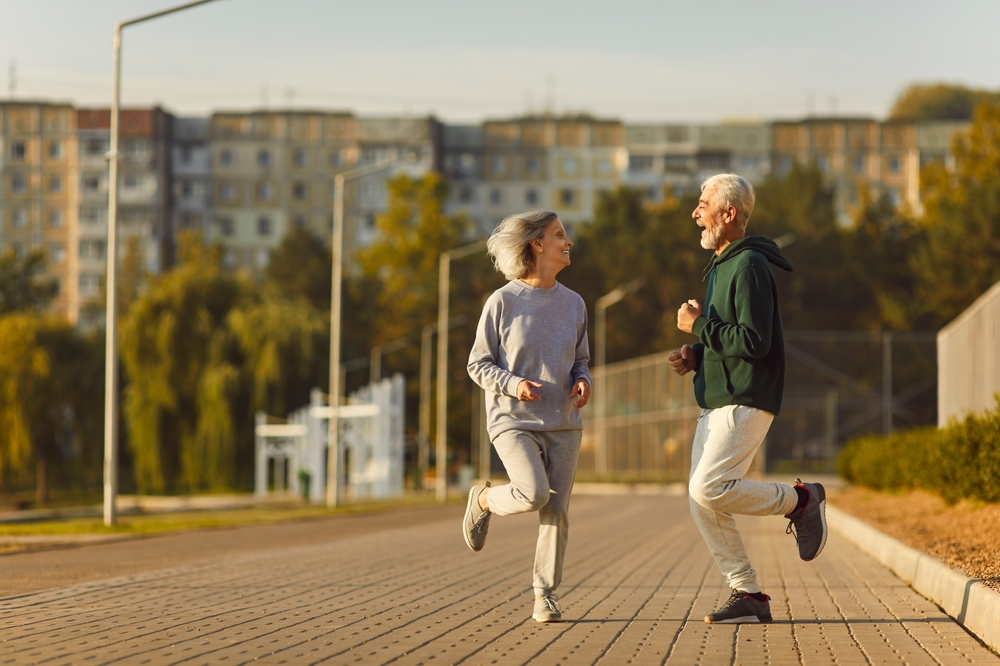Exercise Beats Antidepressants by 50 Percent in Largest Mental Health Study Ever Conducted

Walk into a doctor’s office with depression symptoms and you’ll walk out with a prescription. Maybe an SSRI. Maybe an SNRI. Maybe something newer with a brand name you can’t pronounce and side effects that fill an entire page in tiny print.
Modern medicine has trained us to believe that mental health problems require pharmaceutical solutions. Feeling anxious? Take a pill. Can’t shake depression? Take a different pill. Both? Take two pills. We’ve built an entire healthcare system around this approach, spending billions on medications while overlooking something that costs almost nothing and produces zero negative side effects.
But what if doctors have been writing the wrong prescription all along? What if the most powerful treatment for depression doesn’t come from a laboratory but from something humans have done since the beginning of time? Scientists in Australia spent years analyzing every major study on mental health treatments to find out what actually works. What they discovered challenges everything we think we know about treating depression and anxiety.
Scientists Analyzed 1,039 Trials to Find What Actually Works
Dr. Ben Singh and his research team at the University of South Australia set out to answer a question that should have been settled decades ago. Among all available treatments for depression and anxiety, which ones produce the best outcomes for patients?
Most research focuses on single studies or narrow population groups. Singh wanted the complete picture. His team compiled 97 systematic reviews covering 1,039 trials with 128,119 participants, making it the most exhaustive analysis of mental health treatments ever conducted. Published in the British Journal of Sports Medicine, their work synthesized decades of research across every adult population imaginable.
Researchers examined people with diagnosed mental health disorders, pregnant women, cancer patients, individuals with HIV and kidney disease, and healthy adults experiencing psychological distress. They looked at every treatment approach studied in randomized controlled trials, the gold standard for medical research. Then they compared outcomes to see what delivered real results.
Physical Activity Beat Medications by 50 Percent in Head to Head Comparison

Singh’s team uncovered something pharmaceutical companies don’t advertise and many doctors don’t realize. Physical activity proved 1.5 times more effective than counseling or leading antidepressant medications for reducing symptoms of depression and anxiety.
Not slightly better. Not marginally more helpful. Fifty percent more effective.
Exercise produced a medium effect size of negative 0.43 for depression symptoms, compared to the negative 0.22 to negative 0.37 effect sizes typically seen with psychotherapy and pharmacotherapy. For anxiety, physical activity generated a medium effect size of negative 0.42. Both results represent substantial clinical improvements that surpass conventional treatment approaches.
“Physical activity is known to help improve mental health. Yet despite the evidence, it has not been widely adopted as a first-choice treatment,” Singh explains. Decades of research supporting exercise interventions have somehow failed to change how doctors treat mental health conditions. Pills remain the default despite evidence pointing toward a better solution.
Depression and Anxiety Cost the World Economy $2.5 Trillion Each Year

Mental health disorders represent one of the most expensive healthcare challenges facing humanity. According to World Health Organization data, one in every eight people worldwide lives with a mental disorder. That’s 970 million people struggling with conditions that diminish quality of life and impair daily functioning.
Economic costs stagger the imagination. Poor mental health drains approximately $2.5 trillion from the global economy annually. Projections suggest that figure will balloon to $6 trillion by 2030 as mental health problems continue rising across populations. In Australia alone, one in five people aged 16 to 85 experienced a mental disorder in the past 12 months.
Depression ranks as the leading cause of mental health related disease burden globally, while anxiety disorders affect more people than any other mental health condition. COVID-19 pushed psychological distress rates even higher, with prevalence jumping to between 35 and 38 percent worldwide during the pandemic. We’re facing a mental health crisis that conventional treatments haven’t solved.
Twelve Weeks of Movement Changes Brain Chemistry Faster Than Months of Therapy

Speed matters when someone suffers from depression or anxiety. Every day spent in psychological distress takes a toll on relationships, work performance, and physical health. Singh’s analysis revealed that exercise interventions lasting 12 weeks or shorter produced the most powerful effects on mental health symptoms.
Three months of regular physical activity generated better outcomes than longer programs. Movement changed brain chemistry fast enough that people noticed improvements within weeks, not months or years. Compare that to antidepressant medications, which often require four to six weeks before producing any noticeable benefit and months before reaching full effectiveness.
Psychotherapy typically unfolds over many months or even years of weekly sessions. Cognitive behavioral therapy, one of the most effective talk therapy approaches, usually requires 12 to 20 sessions to show meaningful results. Physical activity matched or exceeded those outcomes in the same timeframe or less, with effects appearing faster for many participants.
Running and Lifting Weights Produced Bigger Effects Than Walking or Yoga
Not all exercise creates equal results for mental health. Singh’s team found that intensity matters when treating depression and anxiety. Higher intensity workouts generated greater symptom improvements compared to gentler forms of movement.
Resistance training showed the largest effects for depression, helping people lift not just weights but also their mood through strength building exercises. Squats, deadlifts, bench presses, and other compound movements that challenge multiple muscle groups appeared particularly beneficial. Something about pushing your physical limits translates directly into better mental health outcomes.
Yoga and other mind body practices excelled at reducing anxiety symptoms. Controlled breathing, meditation, and flowing movements that connect breath to motion helped calm anxious minds more effectively than other exercise modalities. People dealing with anxiety disorders saw especially strong benefits from these gentler but still challenging practices.
Aerobic exercise like running, cycling, and swimming improved both depression and anxiety across all populations studied. Walking, while beneficial, didn’t produce effects as large as more vigorous activities. Pilates, mixed mode training, and virtually every other form of movement showed positive results.
Pregnant Women and Kidney Disease Patients Saw the Biggest Mental Health Gains
Singh’s analysis revealed fascinating patterns in who benefited most from exercise interventions. People with diagnosed depression showed the largest improvements, which makes sense given they had the most room for positive change. Pregnant and postpartum women experienced remarkable mental health gains from physical activity during a time when hormonal changes make them vulnerable to depression.
Individuals with kidney disease saw massive benefits from exercise programs. Kidney disease patients often deal with depression at rates far higher than the general population due to the burden of chronic illness and frequent medical treatments. Physical activity provided relief that medications alone couldn’t deliver.
HIV positive individuals responded powerfully to exercise interventions, with substantial reductions in depression and anxiety symptoms. People with chronic obstructive pulmonary disease also showed strong positive effects. Even healthy adults with no diagnosed conditions improved their mental wellbeing through regular movement.
“Our review shows that physical activity interventions can significantly reduce symptoms of depression and anxiety in all clinical populations, with some groups showing even greater signs of improvement,” Singh notes. Populations with higher baseline symptoms and lower physical activity levels experienced the most dramatic changes, suggesting exercise fills a crucial gap in mental health treatment.
Working Out 150 Minutes Weekly Beats Spending More Time at the Gym

Weekly exercise duration showed a similar pattern to overall program length. Interventions requiring 150 minutes per week or less produced larger mental health improvements than programs demanding more time commitment. Quality trumped quantity in exercise prescriptions for depression and anxiety.
Asking people to exercise for hours every week creates a barrier that many can’t overcome. Work schedules, family responsibilities, and other life demands compete for time and attention. Setting achievable targets increases the likelihood that people will actually do the exercise rather than feeling overwhelmed and giving up.
Shorter weekly durations also feel less burdensome psychologically. Someone facing depression already struggles with motivation and energy. Knowing they need to exercise for just 30 minutes five times a week feels manageable. Being told to spend 300 minutes exercising might trigger avoidance before they even start.
“Importantly, the research shows that it doesn’t take much for exercise to make a positive change to your mental health,” Singh emphasizes. You don’t need to become a fitness fanatic or train like an athlete to experience substantial mental health benefits. Moderate amounts of regular movement suffice to change brain chemistry in ways that relieve depression and anxiety.
Brain Chemistry Shifts Explain Why Sweat Works Better Than Serotonin Drugs
Physical activity triggers a cascade of neurological and hormonal changes that improve mental health through multiple biological pathways. Exercise increases expression of neurotrophic factors, proteins that support neuron survival and growth. Brain derived neurotrophic factor in particular plays a major role in mood regulation and cognitive function.
Movement boosts availability of serotonin and norepinephrine, two neurotransmitters that antidepressant medications try to manipulate. But exercise accomplishes this naturally through increased synthesis and release rather than blocking reuptake artificially like SSRIs do. Your brain produces more of these mood regulating chemicals when you exercise regularly.
Exercise also regulates hypothalamic pituitary adrenal axis activity, the system that controls your stress response. People with depression and anxiety often show dysregulation in this axis, producing excessive cortisol and other stress hormones. Physical activity helps normalize this system, reducing the biological stress response that maintains mental health symptoms.
Systemic inflammation contributes to depression in many people. Exercise reduces inflammatory markers throughout the body, including in the brain. Lower inflammation correlates directly with improved mood and reduced anxiety. Medications that target inflammation show promise for treating depression, but exercise achieves similar anti inflammatory effects without pharmaceutical side effects.
Doctors Keep Prescribing Pills Despite Decades of Evidence for Exercise

Given overwhelming evidence that physical activity outperforms medications for treating depression and anxiety, why do doctors continue writing prescriptions as the first line treatment? Several systemic barriers prevent exercise from becoming standard care despite its proven effectiveness.
Patient resistance plays a role. Someone suffering from depression often lacks the motivation and energy needed to start exercising. Pills seem easier than sweating. People want quick fixes, and popping a medication feels simpler than changing daily habits. Doctors may prescribe medications because they believe patients won’t follow through with exercise recommendations.
Clinical settings make it difficult to prescribe and monitor physical activity interventions. Doctors can write a prescription for medication and verify compliance through pill counts. Exercise requires more complex monitoring and support structures that most medical practices don’t have in place. Insurance reimbursement favors billable procedures and medications over lifestyle counseling.
Mountains of research create their own problem. Hundreds of studies examining different exercise types, intensities, durations, and populations make it hard for busy clinicians to understand what recommendations to give patients. Singh’s umbrella review helps solve this problem by synthesizing all available evidence into clear conclusions, but most doctors haven’t seen it yet.
Mental Health Treatment Needs a Movement Revolution

Singh’s research should trigger a fundamental shift in how healthcare systems approach depression and anxiety. Physical activity deserves recognition as a primary treatment option, not an alternative or complementary approach to try after medications fail. Clinical practice guidelines need updating to reflect what research clearly shows.
Training healthcare providers to prescribe exercise effectively requires changes in medical education. Doctors need practical tools for assessing patients’ physical activity levels, setting realistic exercise goals, and providing ongoing support. Exercise physiologists and physical therapists should become integral members of mental health treatment teams.
Insurance companies and healthcare systems must adapt reimbursement structures to support exercise interventions. Covering gym memberships, fitness classes, and exercise physiology consultations would save money compared to the long term costs of medications, therapy, and emergency psychiatric care. Prevention through physical activity costs less than treating advanced mental health crises.
Patients need to know they have options beyond pills. Doctors should discuss exercise as a first line treatment and help people develop realistic plans for adding movement to their daily lives. Starting small with achievable goals builds confidence and momentum. Even 20 minutes of brisk walking five days a week can change brain chemistry enough to lift mood and reduce anxiety.
Singh’s findings give people struggling with depression and anxiety a powerful tool that’s been available all along. You don’t need a prescription. You don’t need insurance approval. You just need to move your body regularly with enough intensity to challenge yourself. That simple act might be the most effective antidepressant ever discovered.
Loading...

